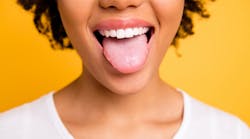Dental clinicians rarely think about tongue posture. Christian Guilleminault, a sleep physician at Stanford University, was a pioneer in the science of sleep apnea. He determined the pathological function of the tongue was a cause for sleep apnea. The tongue needs to be free to move into correct posture.1
Guilleminault determined that during sleep, a child should be able to manipulate their tongue by the age of three to decrease their chances of sleep apnea later in life.1,2 He posited that assessment of mouth breathing during sleep should be systematically performed post-tonsil and adenoid (T&A) removal and the persistence of mouth breathing should be treated with myofunctional therapy (MFT).3
The paper that helped influence my article talks about the tongue in relationship with other body parts.4 The authors point out that a low functioning tongue can lead to TMJ, dysphagia, dysgeusia (distorted taste), and logopedic (speech) problems.
The most interesting part of their article is the compilation of anatomic and neurologic connections of the tongue. What is really happening if the tongue is improperly attached to the floor of the mouth? Since we work in close proximity to the tongue, the science of the tongue could reasonably be owned by dentistry.
For instance, the anatomical relationship between the dorsum of the tongue and the palate brings us to tongue posture. The whole tongue should be against the palate; this is good tongue posture.
You might also be interested in: Tongue tie as a missing link to caries management
Why tongue posture is important
Without good tongue posture from conception forward, there’s a neurological gap between the tongue and palate. The tether holding the tongue down, visible or not, holds the tongue into the pharyngeal airway and keeps the circuit between tongue and palate from closing. The reason for the tethers is still under investigation.
Remember the suprahyoid muscle, the hyoglossus membrane, and the lingual septum? Their attachment to the hyoid bone maintains the posture and equilibrium of the head. Think of your patients with forward head posture. Other muscles involved in head and neck posture that are moved by tongue posture are the omohyoid and anterior belly of the digastric. The tongue engages these and other muscles of the oropharynx for swallowing.
In respiration, the tongue moves the hyoid up and down due to the action of the extrinsic muscles of the tongue opening the pharyngeal space. When healthy, the tongue muscles operate synergistically and must be well balanced or risk misplacing the hyoid.5
The tongue is part of the anatomical structure that includes the posterior and anterior portion of the neck, the muscles of mastication, and three layers of the cervical fascia (superficial, middle, and deep). All those structures are affected by tongue health, tone, and posture.6
The deep cervical fascia extends from the hyoid bone and around the muscles in the prevertebral spaces. The tongue’s role is connected to the strap muscles and the sternocleidomastoid muscle and the musculature acting on the thoracic outlet.7,8
Most important is the neurology between the tongue and two palates. Tongue position influences the whole body.4 The tongue’s position against the hard palate affects the parasympathetic system, and when positioned poorly it will cause an increase in heart rate and respiratory rate. When it’s against the soft palate the sympathetic system will reduce its activity. Thus, good tongue posture affects anxiety and blood pressure.
The mechanism of the tongue posture to lung volume is a complex system of tension in the trachea from changes in the hyoid arch. Pulmonary stretch activates the pleural receptors that work by inhibiting the hypoglossal/phrenic motoneurons.4
If the tongue cannot reach the teeth to clean off debris or feel the molars, there are solutions for the enamel using xylitol and fluoride varnishes such as Voco’s Profluorid Varnish, which helps resist the low pH environment of low tongue posture and oral breathing. Profluorid delivers rebuilding fluoride onto the teeth for hours after application, with a high immediate fluoride release.
Paired with nanohydroxyapatite pastes such as Voco’s Remin Pro, the mineral balance is restored, and additional fluoride is released. Delivering these products can heal early enamel dissolution. We owe our patients a way to save their teeth and their general health. Don’t forget their airway while you’re saving their teeth!
Editor's note: This article appeared in the June 2023 print edition of RDH magazine. Dental hygienists in North America are eligible for a complimentary print subscription. Sign up here.
References
- Guilleminault C, Huang YS, Quo S. Apraxia in children and adults with obstructive sleep apnea syndrome. Sleep. 2019;42(12):168. doi:1093/sleep/zsz168
- Yoon AJ, Zaghi S, Ha S, Law CS, Guilleminault C, Liu SY. Ankyloglossia as a risk factor for maxillary hypoplasia and soft palate elongation: a functional morphological study. Ortho Cranio Res.2017;20(4):237–244. org/10.1111/ocr.12206
- Lee SY, Guilleminault C, Chiu HY, Sullivan SS. Mouth breathing, "nasal disuse," and pediatric sleep-disordered breathing. Sleep Breath. 2015;19(4):1257–1264. doi:1007/s11325-015-1154-6
- Bordoni B, Morabito B, Mitrano R, Simonelli M, Toccafondi A. The anatomical relationships of the tongue with the body system. 2018;10(12):e3695. doi.org/10.7759/cureus.3695
- Zaidi FN, Meadows P, Jacobowitz O, Davidson TM. Tongue anatomy and physiology the scientific basis for a novel targeted neurostimulation system designed for the treatment of obstructive sleep apnea. 2013;16(4):376–386. doi.org/10.1111/j.1525-1403.2012.00514.x
- Gervasio A, D'Orta G, Mujahed I, Biasio A. Sonographic anatomy of the neck: the suprahyoid region. J Ultrasound. 2011;14(3):130–135. org/10.1016/j.jus.2011.06.001
- Gervasio A, Mujahed I, Biasio A, Alessi S. Ultrasound anatomy of the neck: the infrahyoid region. J Ultrasound. 2010;13(3):85–89. doi.org/10.1016/j.jus.2010.09.006
- Sharma M, Pathak A, Shoukat A, Somani P. Imaging of spaces of neck and mediastinum by endoscopic ultrasound. Lung India. 2016;33(3):292–305. org/10.4103/0970-2113.180866







